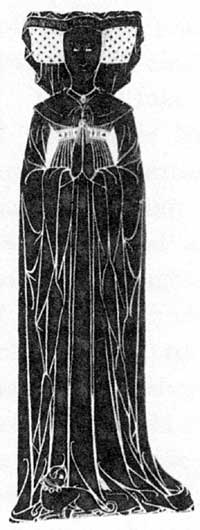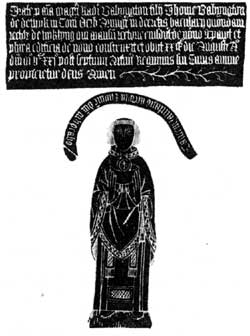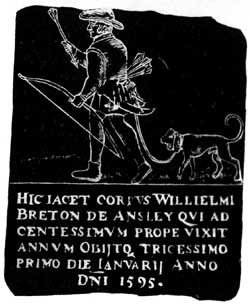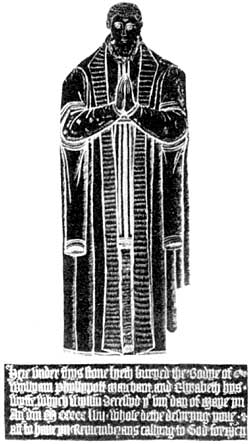
Dame Millicent Meryng, East Markham (1419).
DAME MILLICENT MERYNG. 1419.
CHURCH OF ST. JOHN BAPTIST, EAST MARKHAM.
Dame Millicent Meryng, as her brass records, died in 1419. The brass is to be found in the nave of the Church of St. John Baptist, East Markham. The engraving and design are not excelled in this county.
On her head is the crespine head-dress then in fashion, and consisting in this case of an arrangement of wires with a couvrechef thrown over them. Her hair is kept in position by a wire frame. A gold chain and jewelled cross hang round her neck. Over her shoulders is a square collar turned down, and she wears a short waisted gown, while the sleeves of her kirtle appear under her long, flowing cloak. A pet dog with belled collar is shewn at her feet.
The lady was daughter of Sir John Bekeryng, and married first Sir Nicholas Burdon, then Sir John Markham, and lastly Sir William Meryng. She was mother of John Markham, Lord Chief Justice of England.
The brass is enclosed by a frame 5ft. 3in. by 2ft. 5in. The figure is 46in. in height.
INSCRIPTION.
“Hic jacet Dna Millicentia Meryng quondam
uxor Willim Meryng militis que obiit XXVII September
Anno dni MOCCCCO XIX cujus aie ppicietur deus amen.”
TRANSLATION.
“Here lies the lady Millicent Meryng formerly wife of William Meryng Knight who died the 27th of September in the year of the Lord 1419 on whose soul may God have mercy.”

Radulph Babyngton, Hickling (1521).
RADULPH BABYNCTON. 1521.
CHURCH OF ST. LUKE, HICKLING.
This brass in the Church of St. Luke, Hickling, commemorates Radulph Babyngton, Rector of Hickling, who died in 1521, and is inferior in design and execution to the Stanford brass. The priest wears the amice, alb, stole, maniple, and chasuble. The latter, unlike the Stanford example, is ornamented with an orphrey. The chalice which the priest holds shews the Host, stamped with a cross. The family of Babyngton are commemorated by a tomb in Ashover Church, which includes an effigy of Radulph Babyngton.
The figure is 19in. in height.
SCROLL.
“Calicem salatarem accipiā nome dni invocato.”
TRANSLATION.
“I will receive the cup of salvation and call upon the name of the Lord.”
INSCRIPTION.
“Orate p āiā magri’ Radi Babyngton filii Thome Babyngton./ de dethyk in com’ Derb Armigr in deoretis bacularii quondam/ rector de Hyklyng qui mansū rectorie ejusdem de novo reparuit et / plura edificia de novo construxit et obiit XXIX die Augusti A° / dni M° V° XXI post septimum annum Regiminis sui cujus anime propicietur deus Amen.”
TRANSLATION.
“Pray for the soul of master Radulph Babyngton son of Thomas Babyngton son of Dethick in County Derby Knight Bachelor in Canon Law, formerly Rector of Hickling, who restored anew the dwelling house of the same rectory and built afresh many structures, and died the 29th day of August in the year of the Lord 1521, after the 7th year of his rectorate on whose soul may God have mercy. Amen.”

William Breton in Annesley Hall (1595). [This brass is now in the 'new' Annesley parish church].
WILLIAM BRETON. 1595.
ANNESLEY.
This mutilated brass to William Breton was formerly in Annesley Old Church, but was removed thence to Annesley Hall, as the church is no longer used.
The brass represents a man in hunting costume, with a bow in one hand and an arrow in the other. A dog is attached by a cord to the man’s belt. A hunting knife is also suspended from his belt.
I have tried unsuccessfully to discover the identity of William Breton. The church registers only go back to 1599, otherwise they might have shed some light on the matter.
In records of perambulations of Sherwood Forest made in 1300 and 1538, the names “Breton” and “Bretten” appear in reference to land near Annesley, and possibly William Breton may have been a descendant of the persons there mentioned.
The brass stood in one of the windows of the old church, but none of the inhabitants appear to know its original position.
The brass measures 13in. by 11in.
INSCRIPTION.
“Hic jacet corpvs Willielmi
Breton de Ansley qvi ad
centessirnvm prope vixit
annvm obiitq tricessimo
primo die Ianvarij anno
Dni 1595.
TRANSLATION.
“Here lies the body of William Breton of Annesley who lived until nigh a hundred years of age and died on the thirty-first day of January in the year of our Lord 1595.”

William Phyllypot, Newark (1557).
WILLIAM PHYLLYPOT. 1557.
CHURCH OF ST. MARY MAGDALENE, NEWARK-ON-TRENT.
The brass of William Phyllypot, in the Church of St. Mary Magdalene, Newark-on-Trent, is affixed to the wall of the north aisle. Phyllypot died in 1557, and the brass was on the floor of the south transept till 1811, when it was placed in its present position. The inscription still remains in the south transept. Phyllypot was a liberal benefactor to the poor of Newark.
The dress in which William Phyllypot is shewn is similar to that of the other figure brass in the church, except that in this case the false sleeves of the long gown only reach to the knees. At this period beards are worn, while the hair is now short instead of long. The figure is 305/8in. in height.
INSCRIPTION.
“Here under thys stone lyeth buryed the bodye of
Wyllyam Phyllypott marchant, and Elyzabeth hys
wyffe whych Wyllm decessyd ye VIII day of maye yn
An° dni mccccclvii whose dethe delyryng youe
all to haue yn rememberans callyng to God for men.”
